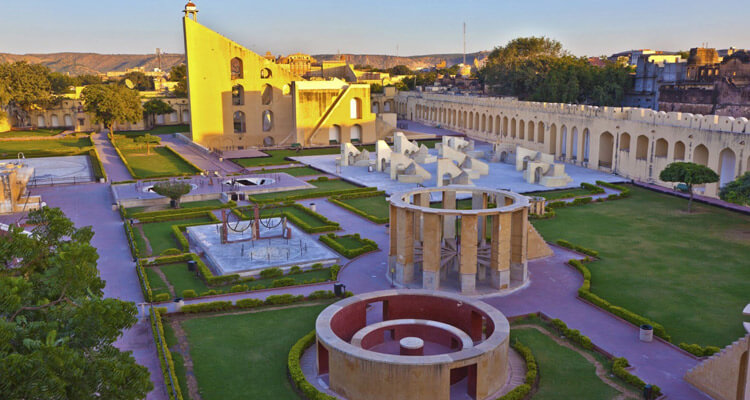Jantar Mantar: Jaipur’s Famous Observatory
In the heart of Jaipur, the vibrant capital city of Rajasthan, stands a magnificent testament to the scientific and architectural genius of ancient India – the Jantar Mantar. This astronomical observatory is not only a showcase of the advanced understanding of celestial movements by Indian astronomers but also a captivating heritage site that has fascinated visitors and scholars alike for centuries. Built in the early 18th century by Maharaja Sawai Jai Singh II, the Jantar Mantar in Jaipur is one of the five such observatories across India, with others located in Delhi, Ujjain, Mathura, and Varanasi. However, the one in Jaipur is the largest and the best-preserved of them all. This article delves into the historic and scientific significance of the Jantar Mantar, uncovering the mysteries of this ancient astronomical marvel.

Jantar Mantar Jaipur Entry Fee
– For Indian visitors: INR 50 per person
– For Indian students (with a valid ID): INR 15 per person
– For foreign visitors: INR 200 per person
– For foreign students (with a valid ID): INR 100 per person
Jantar Mantar in Jaipur is open to visitors daily. The standard visiting hours are from 9:00 AM to 5:00 PM. However, these timings can be subject to change due to special circumstances or government directives.
The Genesis of Jantar Mantar
The inspiration for constructing the Jantar Mantar stemmed from Maharaja Sawai Jai Singh II’s passionate interest in astronomy and his quest for enhancing the accuracy in astronomical measurements that were crucial for determining astrological predictions, time, and calendar. The Maharaja was a learned man, well-versed in various astronomical texts and under his direction, the Jantar Mantar was equipped to observe the astronomical positions with the naked eye. Completed in 1734, it stands as a harbinger of the golden era of Indian astronomy.
Architectural and Astronomical Brilliance
Spanning over an area of approximately 18,700 square meters, the Jantar Mantar of Jaipur houses 19 major astronomical instruments. These instruments were made of local stone and marble, each built on a grand scale to enhance their accuracy. The Samrat Yantra, the largest sundial in the world, is a prime attraction here. Standing 27 meters tall, its shadow moves at up to 4 meters per hour, and it is astonishingly accurate in measuring time to a precision of around 2 seconds.
Another significant instrument is the Jai Prakash Yantra, an ingenious invention by Maharaja Sawai Jai Singh II himself. It consists of two hemispherical cavities that help in tracking the altitude of celestial bodies. The Ram Yantra, used for measuring the altitude and azimuth of the sun and planets, and the Mishra Yantra, a unique composition of five different astronomical instruments, are also worth noting.
A UNESCO World Heritage Site
Recognizing its historical and architectural value, UNESCO declared the Jantar Mantar of Jaipur a World Heritage Site in 2010. This acknowledgment brought global attention to the site, highlighting India’s rich contribution to the field of astronomy and the unique blend of science and architecture. The Jantar Mantar is lauded not only for its scientific purpose but also for its geometric creativity and the precision of its instruments, which are seen as a pinnacle of 18th-century innovation.
The Jantar Mantar Experience
A visit to the Jantar Mantar is akin to stepping back in time to an era when astronomy was intertwined with astrology, philosophy, and timekeeping. It offers a glimpse into the meticulousness and dedication of ancient Indian astronomers. The observatory serves both as a historical monument and a learning center. For those keen on understanding the celestial movements and the history of astronomy, the Jantar Mantar offers guided tours and interpretive panels that explain the purpose and functioning of each instrument.
The site is not only a haven for history buffs and science enthusiasts but also for architects and photographers, drawn by its geometric beauty and the play of light and shadow. The observatory’s strategic location in the city also makes it a convenient stop for tourists visiting Jaipur’s other landmarks.
Planning a Visit to Jantar Mantar, Delhi? All You Need to Know
Preservation and Legacy
The preservation of Jantar Mantar in Jaipur is a matter of paramount importance. Over the centuries, weathering and urbanization posed significant threats to the site. However, efforts by the government and various heritage conservation agencies have ensured its upkeep and restoration, allowing generations to marvel at its grandeur.
The legacy of the Jantar Mantar extends beyond its immediate architectural and scientific achievements. It embodies the enlightened vision of Maharaja Sawai Jai Singh II and showcases the rich intellectual heritage of India. Today, it stands as a source of inspiration, reminding us of the remarkable advancements in Indian astronomy and the timeless pursuit of knowledge.
Conclusion
The Jantar Mantar of Jaipur is a monumental feat, representing the zenith of Indian astronomy and architecture. It is a vivid reminder of mankind’s quest to understand the cosmos and our place within it. In a world where modern technology has taken over the task of celestial observations, the Jantar Mantar serves as a bridge to our past, illustrating the human capacity for wonder and ingenuity.
For anyone visiting Jaipur, the Jantar Mantar is not just an obligatory tourist attraction but a journey into the heart of India’s astronomical prowess and architectural grandeur. It stands not merely as a relic but as a living testament to a time when the sky was a map and the stars were guides. In the hustle and bustle of the city, the Jantar Mantar remains a sanctuary of peace and a beacon of India’s glorious heritage, waiting to be rediscovered by each visitor who walks through its gates.
Discover Delhi’s Best: Top Hospitals, Food Spots, Coaching Institutes, and Doctors







